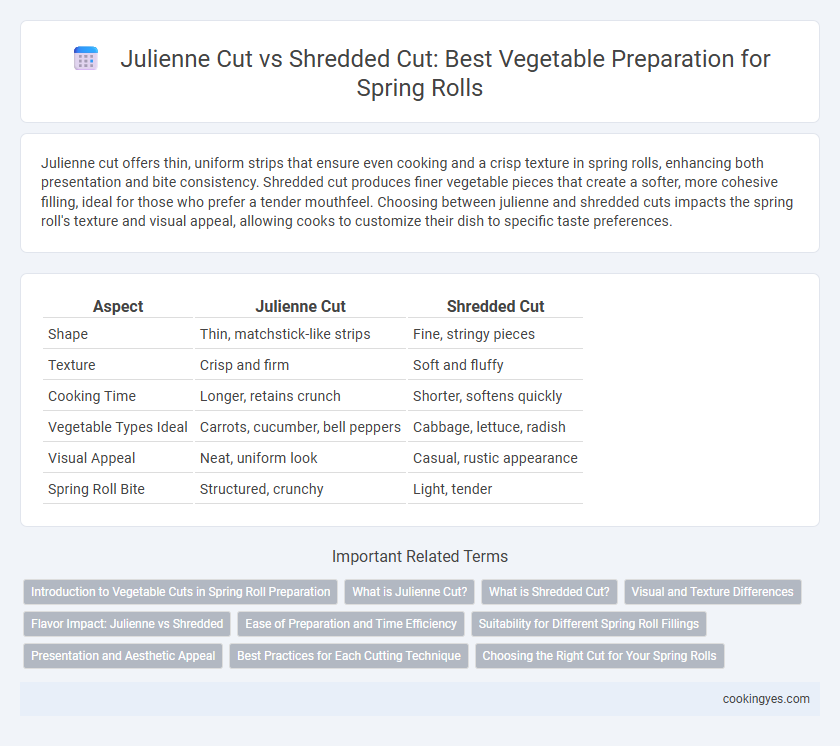Julienne cut offers thin, uniform strips that ensure even cooking and a crisp texture in spring rolls, enhancing both presentation and bite consistency. Shredded cut produces finer vegetable pieces that create a softer, more cohesive filling, ideal for those who prefer a tender mouthfeel. Choosing between julienne and shredded cuts impacts the spring roll's texture and visual appeal, allowing cooks to customize their dish to specific taste preferences.
Table of Comparison
| Aspect | Julienne Cut | Shredded Cut |
|---|---|---|
| Shape | Thin, matchstick-like strips | Fine, stringy pieces |
| Texture | Crisp and firm | Soft and fluffy |
| Cooking Time | Longer, retains crunch | Shorter, softens quickly |
| Vegetable Types Ideal | Carrots, cucumber, bell peppers | Cabbage, lettuce, radish |
| Visual Appeal | Neat, uniform look | Casual, rustic appearance |
| Spring Roll Bite | Structured, crunchy | Light, tender |
Introduction to Vegetable Cuts in Spring Roll Preparation
Julienne cut vegetables, characterized by thin, uniform matchstick strips, enhance the crisp texture and elegant presentation of spring rolls. Shredded cut vegetables offer a finer, softer texture that blends more with other fillings, often used when a tender bite is desired. Choosing between julienne and shredded cuts impacts the overall mouthfeel and aesthetic, influencing the spring roll's appeal and texture balance.
What is Julienne Cut?
Julienne cut is a precise vegetable preparation technique that involves slicing vegetables into thin, matchstick-sized strips, typically about 1/8 inch wide and 2 inches long. This cut enhances the texture and presentation of spring rolls by ensuring even cooking and a crisp bite. Julienne-cut vegetables, such as carrots and cucumbers, provide a balanced visual appeal and maintain structural integrity compared to shredded cuts, which are finer and softer.
What is Shredded Cut?
A shredded cut involves finely separating vegetables into thin, narrow strips, creating a delicate texture ideal for spring roll fillings that require quick cooking and even distribution of flavors. Unlike the julienne cut, which produces uniform matchstick-sized pieces, shredded vegetables have a more irregular, soft consistency that enhances the spring roll's mouthfeel. Common vegetables like cabbage, carrots, and lettuce are shredded to maximize surface area, aiding in moisture release and blending with other ingredients in the spring roll wrap.
Visual and Texture Differences
Julienne cut vegetables in spring rolls create long, thin strips that offer a crisp texture and visually appealing, uniform presentation. Shredded cut produces finer, softer vegetable pieces that blend more easily, resulting in a tender texture and a less structured appearance. The choice between julienne and shredded cuts directly affects the spring roll's crunchiness and overall mouthfeel.
Flavor Impact: Julienne vs Shredded
Julienne-cut vegetables in spring rolls offer a crisp texture and allow each ingredient's natural flavors to shine individually, enhancing the overall freshness and bite of the roll. Shredded vegetables release more moisture and blend flavors together, creating a softer texture with a more uniform taste that complements sauces and fillings. Choosing julienne cuts emphasizes distinct vegetable flavors, while shredded cuts result in a harmonious flavor profile ideal for moist, tender spring rolls.
Ease of Preparation and Time Efficiency
Julienne cut vegetables for spring rolls offer a consistent shape that ensures even cooking and a professional appearance, making preparation straightforward and efficient. Shredded cut vegetables require less precision and can be faster to prepare using tools like box graters or food processors, saving time for large batches. Both cuts enhance texture and flavor, but julienne prioritizes neat presentation while shredded emphasizes convenience and speed.
Suitability for Different Spring Roll Fillings
Julienne cut vegetables offer uniform, thin strips ideal for crisp and fresh spring roll fillings, enhancing texture without overpowering other ingredients. Shredded cut vegetables provide a finer, softer consistency better suited for moist or saucy fillings, allowing flavors to blend more thoroughly. The choice between julienne and shredded cuts depends on the desired texture and the type of filling, such as crunchy fresh rolls versus cooked or sauced spring rolls.
Presentation and Aesthetic Appeal
Julienne cut vegetables offer a uniform, thin, and elongated shape that enhances the spring roll's crisp and elegant presentation, creating clean lines that appeal visually. Shredded cuts provide a softer texture and a more rustic appearance, often resulting in a less structured filling that can affect the roll's overall neatness. Choosing julienne cuts emphasizes precision and delicacy, elevating the aesthetic appeal and making the spring rolls more visually enticing.
Best Practices for Each Cutting Technique
Julienne cut vegetables, typically thin and uniform strips measuring about 1/8 inch by 2 inches, offer a crisp texture and visually appealing presentation ideal for fresh spring rolls. Shredded cuts, finer and more irregular, release more moisture and blend easily with other ingredients, best suited for cooked or steamed spring rolls to enhance softness and flavor integration. Choosing the proper cutting technique depends on the spring roll style, with julienne providing structure and shredded promoting tenderness.
Choosing the Right Cut for Your Spring Rolls
Julienne cut provides thin, uniform strips of vegetables that create a crisp texture and visually appealing, consistent spring rolls. Shredded cut produces finer, softer strands that blend more easily with other fillings, enhancing moisture and tenderness. Choosing between julienne and shredded cuts depends on your desired texture and presentation--julienne for crunch and structure, shredded for tenderness and cohesive filling.
Julienne cut vs shredded cut for vegetable preparation in spring rolls Infographic

 cookingyes.com
cookingyes.com